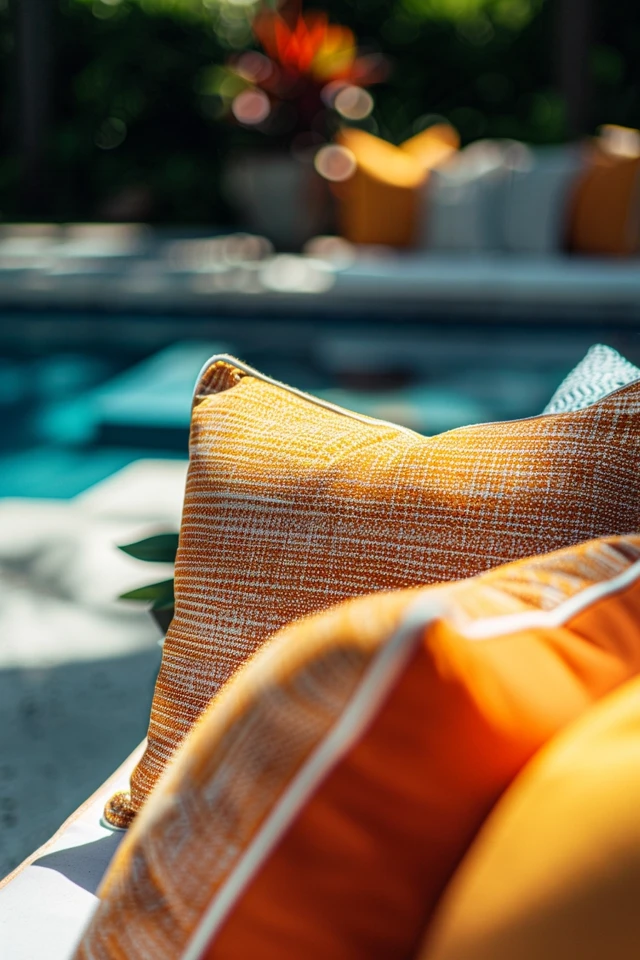Mildew can be a frustrating problem when it comes to outdoor cushions. The unsightly black, blue, or yellow speckled discoloration, along with the musty smell and fuzzy surface, are clear indicators of mildew. Fortunately, there are effective ways to prevent mildew and keep your outdoor cushions looking fresh and clean.
One of the simplest methods is to bring your cushions inside or place them under a shelter when rain is expected. Even if your cushions are water-resistant, this extra precaution can go a long way in preventing moisture from seeping into the fabric and promoting mildew growth.
Another effective step is to treat your outdoor cushions with a waterproof spray. Applying two coats of the spray, making sure not to saturate the cushions, can provide an additional layer of protection against moisture and mildew. Allow the spray to dry thoroughly between coats.
Key Takeaways:
- Bring your outdoor cushions inside or under a shelter when rain is expected.
- Treat your cushions with a waterproof spray for added protection.
- Apply two coats of the waterproof spray, allowing each coat to dry thoroughly.
- Choose mildew-resistant outdoor cushions to reduce the risk of mold and mildew formation.
- Regular maintenance and cleaning of your outdoor cushions can help prevent mildew.

How to Recognize and Clean Mildew on Outdoor Cushions
Recognizing mold on patio cushions is essential before starting the cleaning process. Look for black or green patches on the cushion surface, as well as a distinct musty smell. Discoloration or staining on the cushions can also indicate the presence of mold and mildew.
To clean mildew from outdoor cushions, you can use a variety of cleaning materials and tools such as vinegar, bleach, borax, dish soap, and a scrub brush. Different cleaning solutions work better for different types of mold and stains. Here are some effective cleaning methods for mold on outdoor cushions:
- Vinegar Solution: Mix equal parts of white vinegar and water in a spray bottle. Spray the solution onto the affected areas and let it sit for about 10 minutes. Scrub the cushions gently with a scrub brush and rinse thoroughly.
- Bleach Mixture: Create a mixture of 1 cup of bleach and 1 gallon of water. Apply the solution to the moldy areas using a sponge or brush. Let it sit for 15 minutes and then rinse thoroughly.
- Borax Paste: Make a paste by combining borax and water to achieve a thick consistency. Apply the paste to the moldy spots, gently scrub, and rinse thoroughly.
- Dish Soap and Water: Create a mixture of warm water and mild dish soap. Apply the solution to the affected areas and scrub gently with a brush. Rinse the cushions thoroughly to remove any soap residue.
It’s important to note that when using cleaning solutions, always follow the instructions provided by the manufacturer and wear gloves to protect your skin. After cleaning, be sure to thoroughly rinse and dry the cushions to prevent future mold growth.
In case of stubborn mold or severe discoloration, it may be necessary to consult a professional cleaning service or consider replacing the cushions to ensure a clean and healthy outdoor seating area.

Tips for Preventing Mold on Outdoor Cushions
Prevention is key when it comes to protecting your outdoor cushions from mold. By implementing effective mold prevention techniques, you can keep your cushions mold-free and ensure their longevity.
One of the first steps in mold prevention is choosing the right fabrics for your cushions. Opt for mold-resistant materials like acrylic and olefin, which are designed to resist water and inhibit the growth of mildew.
In addition to selecting the right fabrics, regular cleaning is crucial to prevent mold formation. By removing any potential mold spores, you can eliminate the conditions necessary for mold growth. Be sure to follow the manufacturer’s instructions for cleaning your cushions and use mild, non-toxic cleaning agents.
Proper storage techniques are also essential in keeping outdoor cushions mold-free. Use waterproof covers to shield your cushions from moisture when they are not in use, and store them in a dry and well-ventilated area.
Furthermore, consider applying a fabric sealant to your cushions to create an additional barrier against moisture. This protective layer can help prevent mold growth and extend the lifespan of your cushions. Alternatively, placing a towel between yourself and the cushion can act as a barrier, reducing moisture absorption.
By following these effective mold prevention methods, you can ensure that your patio furniture cushions remain mold-free, allowing you to enjoy your outdoor spaces without any worries.

Source Links
- https://www.housedigest.com/1220349/prevent-mildew-on-your-outdoor-cushions-with-a-treatment-plan/
- https://fj-outdoors.com/blogs/guide/mold-no-more-expert-advice-for-preventing-mold-on-outdoor-cushions
- https://fj-outdoors.com/blogs/guide/banishing-mold-a-comprehensive-guide-to-cleaning-patio-cushions

